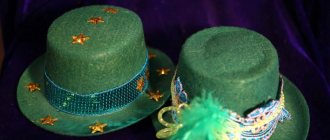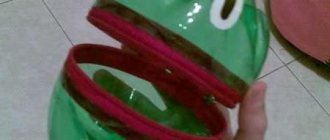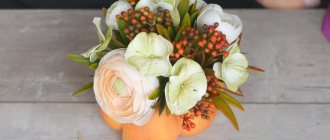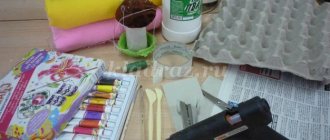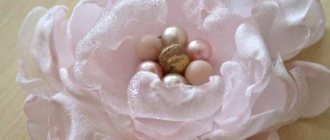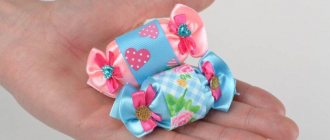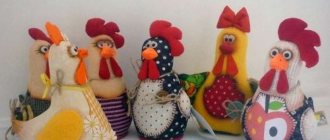You can decorate a painting, photograph, embroidery, etc., in various ways. One of them is a passe-partout or print. At its core, it is cardboard (but you can also use thick paper), made in a special way. Making a mat for a painting with your own hands is very simple; in this article we will tell you about the three most popular methods. There will be videos too.
What to include in a passe-partout
When designing many works, they resort to matting. Often they decorate embroidered paintings with threads, beads, engravings, drawings, photographs... Using mats you can emphasize, highlight the necessary elements or parts of the work, create a 3D effect, the texture of the image... There are many examples of photo mats, where the work has a completely different look than without such a stylish registration
We decorate the work with additional elements
If the needlewoman can not only embroider, but also create in a different direction, you can try decorating the mat with additional elements. The type of decor depends on the cross stitch itself. The main condition is that it must complement the picture on the canvas. Optionally, it can be ribbons, lace, beads, painting and sparkles.
You might be interested in this: Patterns for embroidering flowers with ribbons for beginners
Decor option
Passepartout is the frame of the picture, which is located between it and the frame. It completes the look of the image, separates and continues what is embroidered. It is important to choose the right frame color and determine the optimal parameters. If desired, you can decorate the product.
Color is the basis of the mat
Before creating a mat for a painting, you must first decide on the main color. The entire type of exposure will depend on the color scheme of the frame, because with an unfavorably chosen color, the image can dissolve in the frame and, on the contrary, look very provocative.
There are several tips for choosing colors:
- white color is well suited for black and white photographs and monochrome graphics;
- calm pastel colors are well suited for engravings, which do not distract the eye from the work itself;
- rich colors are an excellent solution for decorating posters;
- black color visually reduces the image.
It is worth noting that when choosing a color for the base of the mat, you need to take into account where the finished work is placed, what design, style, color scheme will be in that room, the work should look harmonious with the environment.
What are there
The passe-partout can be simple and made from a piece of cardboard with an oval or rectangle cut out inside.
You can also make a multi-window product, when several drawings are installed in one main frame, or a composite one using several shades of material. The frame can be deep and consist of 3 or 4 layers of cardboard sheet.
There are several types of passe-partout:
| View | What is it made of? |
| Standard | They use a thick cardboard sheet with different textures and colors. The thickness of the material should be approximately 2 mm. The cut color can be any. Goes well with any artistic work. |
| Glubokoe | The thickness of the cardboard sheet should be about 5 mm. The cutting angle is made at an angle of 45°. This type of mat is used when decorating artwork to create a “tunnel effect”, giving the picture depth. |
| Museum | For production, a special sheet of cardboard is used, which is impregnated with special substances that can protect a very old drawing from the oxidizing effects of the environment. Suitable for decorating rare photographs and drawings that have antique value. |
| Fabric | To decorate the paper base of the frame, any fabric material is used: from matting to velvet in relation to the idea of artwork. It is used when decorating paintings of a figurative nature, for example, a herbarium under glass or a panel. |
What to make a passe-partout from
To make a passe-partout frame with your own hands, you need to prepare the necessary materials in advance. As a rule, mats are made from cardboard, which is created from pressed layers of whatman paper. To ensure that the frame is not white, glue a sheet of paper of the desired color or shade on top. Paper should be used that is well resistant to sunlight and light.
You can also use velvet, silk, suede, cotton to create mats - such materials are great for decorating three-dimensional paintings, displays of weapons, for watches...
Tips for creating a passe-partout
To simplify the creation of a mat for drawing with your own hands, you need to follow the recommendations of experts:
- You should not allow the mat to merge with the image or frame.
- To more clearly delineate the space, use a slip - a thin frame made of wood or plastic.
- For a large, bright painting, a wide frame will work well.
- Is it possible to decorate a passe-partout?
There is more than one way to make a passe-partout with your own hands, as well as different options for decoration. They often use a plain color mat in many works, but there are exceptions and I want to make the work more interesting and original. In such cases, you can do this with the help of decor. To design a passe-partout for an A4 drawing made by a child’s hand, you can use various buttons, beads, miniature toys...
Note!
DIY gifts for February 23rd - a large selection of ideas for creating unusual gifts for Defender of the Fatherland Day
What to give a 2-year-old boy - a list of the best options for an interesting and useful gift (120 photo ideas)
- Papier-mâché - TOP 120 photo reviews of original products. Detailed instructions for beginners on creating beautiful crafts
To decorate a picture with a romantic theme, it is enough to complement the mat with lace, various ribbons, dried roses... Overlays made of brass, pressed and varnished look very beautiful and stylish. This decor looks especially unusual on the mat for drawing A3. You can decorate the passe-partout using transfer vignettes, artistic painting, polymer clay products...
The simplest way
This option will help out if you suddenly didn’t have time to make a craft for school, and you have very little time:
- Choose a sheet of cardboard that is suitable in color and size.
- Without cutting anything out, glue the design onto it, placing it so that there are margins on the sides.
- Insert into a picture or photo frame.
- If you need to decorate.
Easy passe-partout for children's drawings
Children's drawings and appliqués can be beautifully decorated using mats; they will also last longer and can be placed in the room on the wall. There is an easy way to make a mat for drawing with your own hands; for this you will need:
- sheet of white A4 paper;
- ruler;
- scissors;
- children's drawing.
Using a ruler and pencil on a sheet of paper, measure 2 cm from each corner and place dots. Draw an even rectangle at the marked points. Draw 2 diagonals in the rectangle. At the intersection of the diagonals, make a cut and cut lines along the diagonals to the corners of the rectangle. Using a ruler, carefully bend all the cut elements outward. Carefully place the drawing or applique into the resulting frame. Bend the bent parts of the rectangle along the outer contour. With this simple method it is also easy to make a passe-partout for an A3 drawing with your own hands.
Price
Before choosing a passe-partout to suit your taste, check out the price range. Assortment presented in specialized stores, incl. and on the Internet, very large. When choosing, inspect the product, turn it over, checking both sides to make sure there are no defects. The price often includes cutting out a window for your poster, photograph or other work:
| Name | Dimensions (external and internal) | Price in rubles |
| Green Moss | A4 21×29.7 cm, A5 21×14.8 cm | 130 |
| Green Moss | A3 29.7×42 cm, A4 21×29.7 cm | 210 |
| Green Moss | 70×100cm, 50×70cm | 590 |
| Red raspberry | A4 21×29.7 cm, A5 21×14.8 cm | 130 |
| Red raspberry | A2 42×59.4 cm, A3 29.7×42 cm | 350 |
| Snow white | A1 59.4×84.1 cm, A2 42×59.4 cm | 480 |
| Black | A4 21×29.7 cm, A5 21×14.8 cm | 130 |
| Cream | 70×100cm, 50×70cm | 590 |
A simple passe-partout for an embroidered picture
Before starting work, it is worth deciding what dimensions are needed, because the frame should be approximately 4-7 cm larger than the embroidered picture on each side. You also need to take into account that cardboard or paper, the finished embroidery should be approximately 2 mm smaller in size than the frame itself. Otherwise, the embroidery will either fall out or it will not be possible to close the frame tightly.
Using a ruler and pencil, draw a rectangle or square of a certain size (depending on the format of the embroidered picture). In the drawn figure, draw 2 diagonals, make cuts along them with scissors or a stationery knife. Carefully cut out the inner square or rectangle, fold the edge inward so that the edges are even. Glue the passe-partout onto the base using glue or double-sided tape.
Margin sizes
The general rule is that for a large and bright painting there should be wide margins, for small works narrow ones, but they should not be less than 3 centimeters.
The optimal size is considered to be 1/3 of the width of the narrow side of the image. Finished frames usually have equal dimensions for all fields. This is convenient for use in any design - portrait or landscape.
For visual perception in finished form, such symmetry is not always good. When vertically positioned strictly in the geometric center with fields of the same width, there is a feeling that the picture is lowered down.
If you make the bottom margin a little wider than the top, the visual design will be perceived as correct. This is called the optical center effect.
On a note. In order for the mat to slightly cover the edges of the image, the window size should be 3-5 mm smaller than the image.
Passepartout made of corrugated paper
The work, framed in a mat made of corrugated paper, looks original, beautiful, and interesting. This unusual design suits the different design and style of the room where the finished work will be located. You can use a mat made of corrugated paper to decorate paintings embroidered with threads or beads, artistic drawings, and children's works. In order for the corrugated paper to soften a little and not break so much, you can iron it through the fabric.
Use a ruler to take measurements from the cardboard backing. Carefully draw a rectangle on a sheet of corrugated paper so that all sides are 4-7 cm larger than the sides of the finished embroidery. Cut out the resulting rectangle and place it face down. Now you should draw a rectangle the size of embroidery, draw diagonals in it. Carefully cut the diagonal lines with a knife, wrap them and place the embroidered picture inside. Thus, the passe-partout is ready and can be installed in a frame under glass.
With edging
A simple method, the result is a neat, beautiful design:
- Calculate and cut out the paper base as in the previous versions.
- Cut strips 4 cm wide from beautiful paper of the desired color. Two equal to the height of the window and two equal to the width.
- Fold the strips lengthwise along the entire length.
- Place the strips on the back side of the window so that a 1-2 mm edge protrudes from the front side.
- Trim the inner corners and glue the piping to the base.
- After the glue has dried, attach the design from the inside out.
- Secure with glue or tape.
It is better to make the edging in a contrasting color so that it identifies the design and focuses attention on it.
Passepartout made of floral felt
A do-it-yourself mat made from floral felt looks very unusual; such work will attract the attention of many. With the help of such a mat you can decorate photographs, children's drawings and appliqués, various posters, embroidered paintings with beads, threads, rhinestones... On the Internet you can find many different photo examples with exquisite decorative elements; using a material such as felt you can make a real masterpiece. The finished work in such an interesting mat will look more advantageous and attract attention.
Note!
- Kinusaiga technique - TOP-140 photos of the best ways to create crafts using the Kinusaiga technique with your own hands + instructions for beginners
- Decoupage with napkins: TOP-150 photos of ways to decorate with napkins. Simple instructions for beginners at home
Amigurumi: features of do-it-yourself knitting technique. Step-by-step master class on making toys for beginners + 180 photos
For a floral felt mat for an embroidered picture you will need:
- floral felt of the desired color;
- Ruler and pencil;
- stretcher;
- embroidered picture with white indent margins;
- cardboard the size of a stretcher;
- super glue or glue gun and sticks for it;
- scissors.
It is worth considering that the stretcher should be larger than the embroidered picture, approximately 4-7 cm on each side. Glue the embroidered picture onto the cardboard using glue or a glue gun. From felt sheets, cut out 2 rectangles the size of cardboard with embroidery glued on. In the center of the felt, draw a rectangle the size of the embroidery itself and carefully cut out 2 such rectangles. Glue the resulting frames in 2 layers onto a cardboard backing. Place the finished result on the stretcher.
If desired, such a passe-partout can be decorated with decorative beads, stones, seed beads...
Window shape
A window is a hole cut out in a paper base for a photo or picture. The shape can be square, rectangular, polygonal, round, oval.
Rectangular can be positioned vertically or horizontally. When creating collages from photographs, different forms can be used simultaneously.
The cardboard around is called the margins - top, bottom and side.
Do I need to take a training course to create a passe-partout?
To make a passe-partout with your own hands, you don’t have to take any courses or online lessons. It is enough to watch a video example or find step-by-step instructions and follow them, use them as an example and supplement the passe-partout with your own ideas. To create a mat, you don’t need any special skills or abilities, you just need to be patient, allocate the necessary time, imagine the finished mat and start creating. There are a huge number of different mats on the Internet that can serve as an impetus for creating your own masterpiece.
Ideas for your inspiration
* All photos are clickable, taken from Pinterest, and copyrights are reserved.
In general, the passe-partout can be decorated in any way and with anything. It all depends on your imagination, but such a frame will look great!



